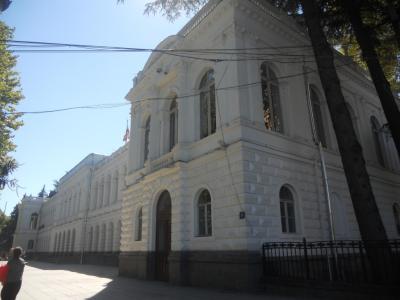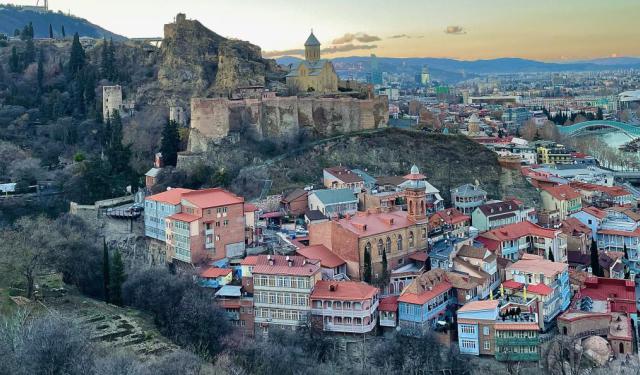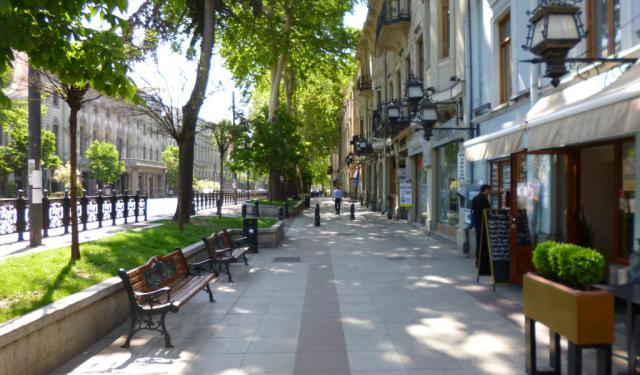
National Youth and Children's Palace, Tbilisi
The National Youth and Children's Palace, also known as Pioneer Palace, National Palace, or its original name - Viceroy's Palace, is a historic edifice situated on Rustaveli Avenue in Tbilisi.
The building's origins date back to 1802 when the Russian government established its presence in Georgia. A new palace was built in 1807, showcasing Russian classicism and becoming the most magnificent building in Tbilisi at the time. The palace underwent multiple reconstructions, with architect Brownmiller transforming it into the true residence of the Commander-in-Chief in 1818. Between 1845 and 1847, architect Semyonov extensively renovated the palace, giving it a distinctive neoclassical appearance. The palace garden and a fountain were added during this period.
In 1865, Otto Jakob Simonson, a Swedish architect working in Tbilisi, embarked on a comprehensive reconstruction project that spanned four years. By 1869, the Viceroy's Palace assumed its final form, which is the structure we see today. Simonson substantially expanded upon Semyonov's design, breathing new life into the palace.
In 1917, the palace became the headquarters of the Transcaucasian Democratic Federative Republic. On May 26, 1918, the federation dissolved in the palace. Later that day, Georgia's National Council met there and declared independence. Two days later, Azerbaijan also declared independence in the same palace. The Government of Georgia then occupied the palace, serving as the initial seat for the National Council and the Constituent Assembly. On February 21, 1921, the Democratic Republic's Constitution was adopted in these chambers. In 1937, the palace was entrusted to children, and on April 2, 1941, it opened its doors to them.
The building's origins date back to 1802 when the Russian government established its presence in Georgia. A new palace was built in 1807, showcasing Russian classicism and becoming the most magnificent building in Tbilisi at the time. The palace underwent multiple reconstructions, with architect Brownmiller transforming it into the true residence of the Commander-in-Chief in 1818. Between 1845 and 1847, architect Semyonov extensively renovated the palace, giving it a distinctive neoclassical appearance. The palace garden and a fountain were added during this period.
In 1865, Otto Jakob Simonson, a Swedish architect working in Tbilisi, embarked on a comprehensive reconstruction project that spanned four years. By 1869, the Viceroy's Palace assumed its final form, which is the structure we see today. Simonson substantially expanded upon Semyonov's design, breathing new life into the palace.
In 1917, the palace became the headquarters of the Transcaucasian Democratic Federative Republic. On May 26, 1918, the federation dissolved in the palace. Later that day, Georgia's National Council met there and declared independence. Two days later, Azerbaijan also declared independence in the same palace. The Government of Georgia then occupied the palace, serving as the initial seat for the National Council and the Constituent Assembly. On February 21, 1921, the Democratic Republic's Constitution was adopted in these chambers. In 1937, the palace was entrusted to children, and on April 2, 1941, it opened its doors to them.
Want to visit this sight? Check out these Self-Guided Walking Tours in Tbilisi. Alternatively, you can download the mobile app "GPSmyCity: Walks in 1K+ Cities" from Apple App Store or Google Play Store. The app turns your mobile device to a personal tour guide and it works offline, so no data plan is needed when traveling abroad.
National Youth and Children's Palace on Map
Sight Name: National Youth and Children's Palace
Sight Location: Tbilisi, Georgia (See walking tours in Tbilisi)
Sight Type: Attraction/Landmark
Guide(s) Containing This Sight:
Sight Location: Tbilisi, Georgia (See walking tours in Tbilisi)
Sight Type: Attraction/Landmark
Guide(s) Containing This Sight:
Walking Tours in Tbilisi, Georgia
Create Your Own Walk in Tbilisi
Creating your own self-guided walk in Tbilisi is easy and fun. Choose the city attractions that you want to see and a walk route map will be created just for you. You can even set your hotel as the start point of the walk.
Tbilisi Introduction Walking Tour
A gateway to Georgia straddling the Mtkvari (Kura) River, the country's capital Tbilisi is one of the most historic cities in the Caucasus region, dating back over a thousand years. It was founded in the 5th century AD by the monarch of Iberia (Georgia's ancient precursor), King Vakhtang I Gorgasali.
According to legend, the king's falcon found the hot springs, near which the... view more
Tour Duration: 2 Hour(s)
Travel Distance: 3.8 Km or 2.4 Miles
According to legend, the king's falcon found the hot springs, near which the... view more
Tour Duration: 2 Hour(s)
Travel Distance: 3.8 Km or 2.4 Miles
Rustaveli Avenue Walking Tour
If Tbilisi is the heart of Georgia, then Rustaveli Avenue is its pulse. As the capital's main artery, the importance – historical, cultural, or architectural – of this vibrant and bustling thoroughfare is hard to overestimate.
Named after the renowned medieval Georgian poet Shota Rustaveli, the avenue starts from Freedom Square – a key downtown landmark, home to the iconic statue of... view more
Tour Duration: 2 Hour(s)
Travel Distance: 2.5 Km or 1.6 Miles
Named after the renowned medieval Georgian poet Shota Rustaveli, the avenue starts from Freedom Square – a key downtown landmark, home to the iconic statue of... view more
Tour Duration: 2 Hour(s)
Travel Distance: 2.5 Km or 1.6 Miles


